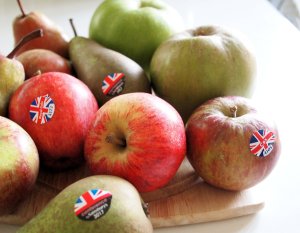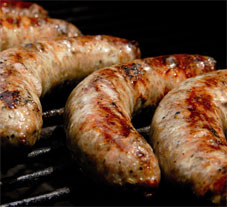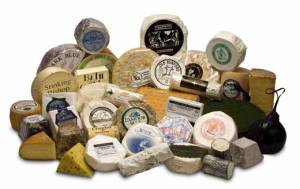Why do so many traditional British dishes sound like euphemisms for sex? “Oh aye, I gave her a right serving of me Ploughman’s Lunch.” “Going home for a bit of the old Yorkshire Pudding (wink, wink, nudge, nudge).” “She’s a lovely bit of Crumpet.” Bangers and Mash doesn’t even require much imagination to make it sound naughty. Cream Tea anyone?
I ask you? These people are so rude! What do you mean it’s just me…
But wherever you are you gotta eat (words of wisdom from some mother no doubt). This can be quite a worrying fact of human life when one is in a foreign country. There are, of course, inevitable universals—like the McDonald’s sign indelibly fixed to part of the wall around the Tower of London pointing tourists in the right direction for the nearest heart attack. More recently, Subway has firmly transplanted itself in the UK. I remember vividly when the first beloved sandwich shop opened in Harrogate. I did a little dance. Literally.
Outside of fast food options, it seems anywhere you go in the Western World, you can find a version of a grilled cheese sandwich (in the UK, ask for a cheese toastie or simply “cheese on toast”) and apple pie (here they call it “apple pie” but you get it smothered in warm custard rather than with a scoop of ice cream). Hot cheese on bread and apples in crust aside, there are aspects of English cuisine that seem exotic–or at least strange–right up until the time you actually eat it.
For those of you new to Britain, contemplating a trip to Britain or simply curious about what all this weird sounding food is really all about, let me offer the following anecdotes from my own explorations into British Food.
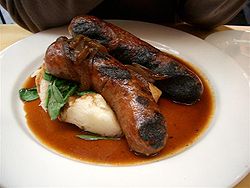 Bangers and Mash. This is a rather risque name for a frankly vanilla sort of meal. The “mash” is mashed potato and “bangers” are sausages. (The term is also used by some as a slang term for breasts, but if you are ordering in a pub you will not get a bodacious waitress inviting you to eat potato from her cleavage. Sorry to spoil the fantasy.) English sausages can vary wildly in quality—from the utterly marvelous to the barely digestible. If you are purchasing from a grocery store, the varieties of sausage will amaze you. Like many food products, the varieties are given regional names: Lincolnshire, Cumberland, Aberdeen Angus etc. Should be served with a rich, onion gravy or a tin of beans.
Bangers and Mash. This is a rather risque name for a frankly vanilla sort of meal. The “mash” is mashed potato and “bangers” are sausages. (The term is also used by some as a slang term for breasts, but if you are ordering in a pub you will not get a bodacious waitress inviting you to eat potato from her cleavage. Sorry to spoil the fantasy.) English sausages can vary wildly in quality—from the utterly marvelous to the barely digestible. If you are purchasing from a grocery store, the varieties of sausage will amaze you. Like many food products, the varieties are given regional names: Lincolnshire, Cumberland, Aberdeen Angus etc. Should be served with a rich, onion gravy or a tin of beans.
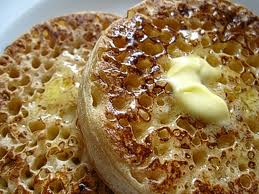 Crumpets. Crumpets are very difficult to describe to an American because we really have no equivalent. They are generally served in similar ways and under similar eating conditions as American biscuits (which the English have no concept of) or English Muffins (only here they are just called “muffins”). Visually they are approximately the same size as a muffin and smothered with butter/butter-like product and either jam, honey or marmite. (Marmite is a controversial topic deserving a separate post of its own). But the texture of a crumpet is completely different. They are chewy for starters, not flaky or crispy at all. Though if toasted properly, they can get a slight crispy edge to the top. They have a subtle sourdough flavour. Serve warm with a hot cup of tea.
Crumpets. Crumpets are very difficult to describe to an American because we really have no equivalent. They are generally served in similar ways and under similar eating conditions as American biscuits (which the English have no concept of) or English Muffins (only here they are just called “muffins”). Visually they are approximately the same size as a muffin and smothered with butter/butter-like product and either jam, honey or marmite. (Marmite is a controversial topic deserving a separate post of its own). But the texture of a crumpet is completely different. They are chewy for starters, not flaky or crispy at all. Though if toasted properly, they can get a slight crispy edge to the top. They have a subtle sourdough flavour. Serve warm with a hot cup of tea.
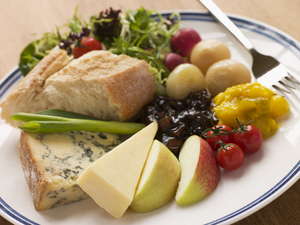 Ploughman’s Lunch. This is another one of those English dishes that sounds far more terrifying than it actually is. At most cafes in this country, including those at major and minor tourist destinations, you will see a Ploughman’s Lunch advertised, but mostly likely will avoid it out of sheer terror and/or confusion. A Ploughman’s Lunch could not be more Yankee friendly if it tried. It’s basically a just a cold plate of cheeses, meats, salad and a roll generally served with some kind of relish, pickle or chutney. I convinced my Dad to try it a few years ago and it has become his lunch of choice in the UK.
Ploughman’s Lunch. This is another one of those English dishes that sounds far more terrifying than it actually is. At most cafes in this country, including those at major and minor tourist destinations, you will see a Ploughman’s Lunch advertised, but mostly likely will avoid it out of sheer terror and/or confusion. A Ploughman’s Lunch could not be more Yankee friendly if it tried. It’s basically a just a cold plate of cheeses, meats, salad and a roll generally served with some kind of relish, pickle or chutney. I convinced my Dad to try it a few years ago and it has become his lunch of choice in the UK.
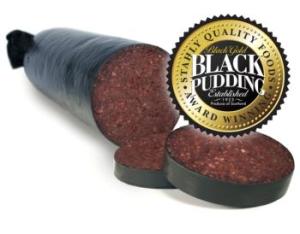 Black Pudding. Also known as blood sausage, Black Pudding often takes a starring role in people’s nightmares about English food. My sadistic brother-in-law, well-known fan of Black Pudding, could not wait to force it on me. Interestingly, England is not the only country which has black/blood pudding on its menu. Most European as well as many Asian countries produce a sausage whose primary ingredient is congealed animal (usually pig) blood and grain fillers such as oatmeal. In the UK, Black Pudding commonly comes in a log and is sliced and fried as part of a cooked breakfast. But what does blood sausage actually taste like? Have I dared to eat it? Could I even look at it without fainting? Sorry to disappoint you, but Black Pudding tastes pretty much like a rich, meaty textured sausage. Nothing scary at all.
Black Pudding. Also known as blood sausage, Black Pudding often takes a starring role in people’s nightmares about English food. My sadistic brother-in-law, well-known fan of Black Pudding, could not wait to force it on me. Interestingly, England is not the only country which has black/blood pudding on its menu. Most European as well as many Asian countries produce a sausage whose primary ingredient is congealed animal (usually pig) blood and grain fillers such as oatmeal. In the UK, Black Pudding commonly comes in a log and is sliced and fried as part of a cooked breakfast. But what does blood sausage actually taste like? Have I dared to eat it? Could I even look at it without fainting? Sorry to disappoint you, but Black Pudding tastes pretty much like a rich, meaty textured sausage. Nothing scary at all.
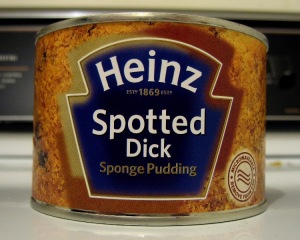 Spotted Dick. Even the Brits admit this one sounds like some kind of sexually transmitted disease. It is, in fact, one of the many delicious varieties of steamed sponge pudding. Imagine taking something that is essentially cake batter, but instead of baking it, you steam it in a sealed, buttered bowl. I have no idea where the “dick” part comes into it, but the “spots” are raisins. Drench it in warm custard and enjoy.
Spotted Dick. Even the Brits admit this one sounds like some kind of sexually transmitted disease. It is, in fact, one of the many delicious varieties of steamed sponge pudding. Imagine taking something that is essentially cake batter, but instead of baking it, you steam it in a sealed, buttered bowl. I have no idea where the “dick” part comes into it, but the “spots” are raisins. Drench it in warm custard and enjoy.
 Yorkshire Pudding. Contrary to logic, Yorkshire Pudding is not a dessert—though its basic recipe is similar to unsweetened pancake batter. Yorkshire pudding is essentially a side dish for a savoury meal, usually roast beef or sausage, served with liberal amounts of gravy. Perhaps the nearest example America has to it is the way biscuits are sometimes served with fried chicken or sausage gravy. The flavour, texture and cooking method are like nothing else I have experienced. It’s a crispy, chewy, slightly fluffy, sort of fried pancake. My husband, eldest daughter and mother are utterly devoted to this dish. Personally, I can take it or leave it but I usually keep my ambivalence quiet because folk in my neck of the moors get very passionate about their Yorkshires.
Yorkshire Pudding. Contrary to logic, Yorkshire Pudding is not a dessert—though its basic recipe is similar to unsweetened pancake batter. Yorkshire pudding is essentially a side dish for a savoury meal, usually roast beef or sausage, served with liberal amounts of gravy. Perhaps the nearest example America has to it is the way biscuits are sometimes served with fried chicken or sausage gravy. The flavour, texture and cooking method are like nothing else I have experienced. It’s a crispy, chewy, slightly fluffy, sort of fried pancake. My husband, eldest daughter and mother are utterly devoted to this dish. Personally, I can take it or leave it but I usually keep my ambivalence quiet because folk in my neck of the moors get very passionate about their Yorkshires.

